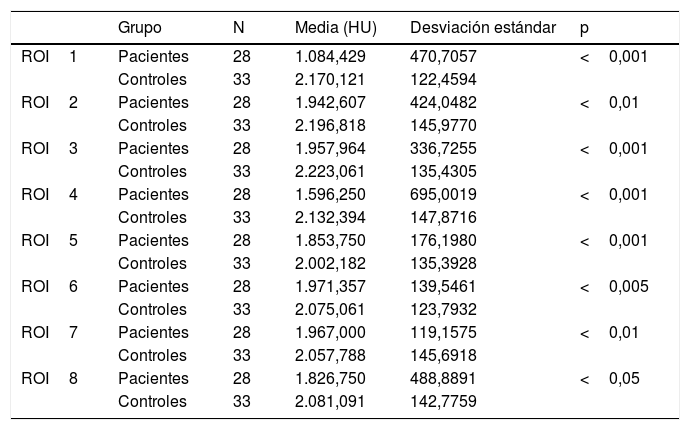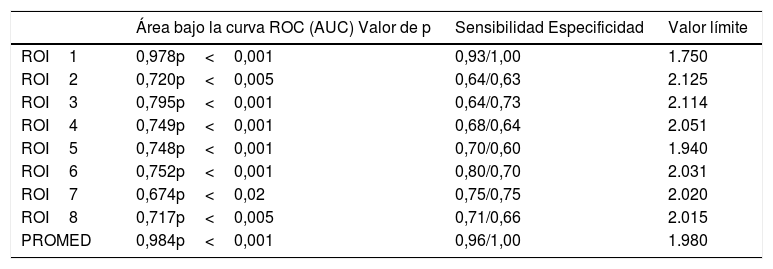El objetivo de este estudio es comparar la densidad ósea alrededor de la cápsula ótica en pacientes otosclerosos con un grupo control y encontrar el límite de densidad ósea a partir del cual podemos diagnosticar la enfermedad.
Material y métodosSe realizó un estudio retrospectivo de casos y controles. La densidad ósea en unidades de Hounsfield (HU) de 28 oídos otosclerosos fue comparada con la densidad de 33 cápsulas no otoscleróticas. La densidad fue medida en 8 áreas de interés (ROI) donde normalmente se encuentran los focos otoscleróticos. Adicionalmente se realizó la densidad media de estas regiones (PROMED). Además, se calcularon las curvas ROC de cada ROI y la densidad media (PROMED).
ResultadosTodas las densidades radiológicas en HU de cada ROI y la densidad media en pacientes otosclerosos fueron menores en comparación con los oídos no otosclerosos. El área bajo la curva ROC de cada ROI y la densidad media mostraron que las áreas con mayor rendimiento diagnóstico fueron la densidad media, la fissula antefenestram y la región precoclear, con valores de corte de 1.980, 1.750 y 2.114HU, respectivamente.
ConclusiónLa densidad media de la cápsula ótica (PROMED), la densidad en fissula antefenestram (ROI1) y en la región precoclear (ROI3) parecen ser los parámetros más útiles para realizar el diagnóstico de otosclerosis.
The aim of this study is to compare the bone density around the otic capsule in otosclerotic patients with a control group, and find the cut-off values of bone density from which we can diagnose the disease.
Material and methodsA retrospective case-control study was performed. Bone densities in Hounsfield units (HU) from 28 otosclerotic ears were compared to the densities of 33 non otosclerotic capsules. These densities were measured in eight regions of interest (ROI) where the otosclerotic foci are usually found. The mean density of these regions (PROMED) was taken. Furthermore, the ROC curves of each ROI and the mean density (PROMED) were calculated.
ResultsAll radiological densities in HU of each ROI and the mean density in otosclerotic patients were lower compared to non otosclerotic ears. The area under the ROC curve of each ROI and the mean density showed that the areas with greater accuracy for the diagnosis of otosclerosis were mean density, the fissula ante fenestram, and precochlear region, with cut-off values of 1980HU, 1750HU and 2114HU, respectively.
ConclusionThe mean density of the otic capsule (PROMED), the density in the fissula ante fenestram (ROI1) and in the precochlear region (ROI3) seem to be the most useful parameters to make a diagnosis of otosclerosis.










